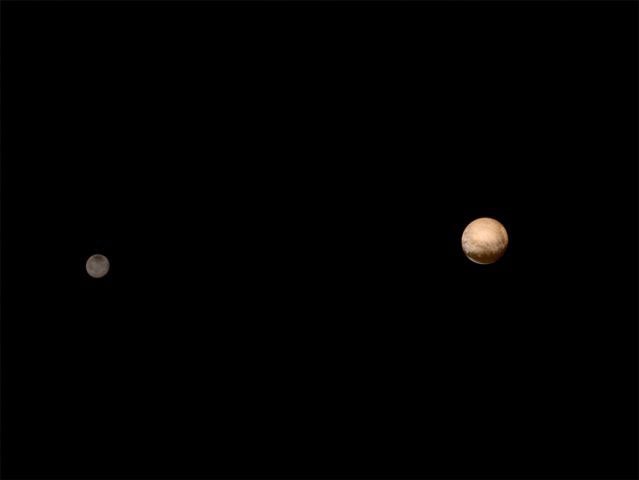New Horizons: Pluto craft set for historic flyby, giving detailed view of planet it has already shown to be bigger than we thought
‘We're going to knock your socks off,’ the mission’s principal scientists has told reporters

Your support helps us to tell the story
From reproductive rights to climate change to Big Tech, The Independent is on the ground when the story is developing. Whether it's investigating the financials of Elon Musk's pro-Trump PAC or producing our latest documentary, 'The A Word', which shines a light on the American women fighting for reproductive rights, we know how important it is to parse out the facts from the messaging.
At such a critical moment in US history, we need reporters on the ground. Your donation allows us to keep sending journalists to speak to both sides of the story.
The Independent is trusted by Americans across the entire political spectrum. And unlike many other quality news outlets, we choose not to lock Americans out of our reporting and analysis with paywalls. We believe quality journalism should be available to everyone, paid for by those who can afford it.
Your support makes all the difference.The New Horizons spacecraft is set to finally get its long-awaited glimpse at Pluto — nine years and three-billion miles into its journey to the dwarf planet.
The craft is taking with it the ashes of the astronomer that discovered it, and is set to provide more information than ever before on the makeup of the icy planet.
When the mission was launched in January 2006, the aim was to reach the outermost of the sun's family of nine planets. Seven months into the probe's epic journey, international astronomers down-graded Pluto's status to "dwarf planet".
But despite its small size - just two thirds the diameter of the Earth's moon - Pluto looks and behaves like a fully-fledged planet, having an atmosphere and no less than five moons of its own.
Currently, Pluto is just under three billion miles from Earth, one of a number of distant "worldlets" in a region known as the Kuiper Belt.
It is so far away that its light takes more than four hours to reach the Earth, making communication with New Horizons an exercise in patience.
The spacecraft is due to make an historic fly-by of Pluto at 12.49pm tomorrow, UK time, during which it will pass within 12,500 kilometres (7,767 miles) of the object.
Its main imaging camera will send back the first detailed close-up pictures of the surface of Pluto, showing features just 50 metres across.
The 700 million dollar (£451 million) probe, the size of a baby grand piano, has journeyed a distance of three billion miles and with a speed of more than 36,000 mph is the fastest craft ever to leave Earth orbit.
British astronomer Brendan Owens, from the Greenwich Royal Observatory in London, said: "This is really unexplored territory. The images of Pluto we got previously have been only a few pixels across, just showing areas of light and dark on this world.
"Now we're getting up close and personal, something that has never been done before. This whole region is hard for astronomers to explore because we rely on light, and at that distance so little sunlight falls on these objects that you have very little data to work with.
"Learning about the composition of Pluto may give us more of a handle on the make-up of the solar system."
The mission marks the conclusion of the American space agency Nasa's quest to explore every planet in the solar system, starting with Venus in 1962.
Tomorrow's encounter with Pluto coincides with the 50th anniversary of the first ever fly-by of Mars by the Mariner 4 probe.
A tantalising early image received from New Horizons last week showed Pluto as a copper-coloured globe bearing a large bright spot in the shape of a heart.
Later photos taken from a million miles away have revealed cliffs, craters and chasms larger than the Earth's Grand Canyon.
The mission's principal scientist Alan Stern told the Associated Press news agency: "We're going to knock your socks off.
"What Nasa's doing with New Horizon is unprecedented in our time.. the last picture show for a very, very long time."
Pluto has a thin atmosphere of nitrogen, methane and carbon dioxide, which expands as the dwarf planet's elongated 248-year orbit takes it closer to the sun causing icy material on its surface to vaporise.
Since its discovery, only a third of Pluto's year - the time it takes to complete one orbit the sun - has passed.
Scientists believe the dwarf planet may bear signs of past volcanic activity and could even have liquid water beneath its frozen surface.
New Horizons team member Professor Bill McKinnon, from Washington University in St Louis, said: "I'm really hoping to see a very active and dynamic world."
The spacecraft will also take a look at Pluto's giant moon Charon, which is just over half its size, as well as its other moons Styx, Nix, Hydra and Kerberos.
As well as a telescopic camera, the probe also carries a suite of sophisticated instruments for analysing Pluto's composition and studying its atmosphere.
Pluto was identified in 1930 by US astronomer Clyde Tombaugh using a 13-inch photographic telescope at the Lowell Observatory in Flagstaff, Arizona.
Some of his ashes are being carried to the world he discovered on New Horizons.
Because of the probe's great distance from Earth and the slow speed of data transmission, it will take many months to process information from the mission.
Additional reporting by Press Association
Join our commenting forum
Join thought-provoking conversations, follow other Independent readers and see their replies
Comments